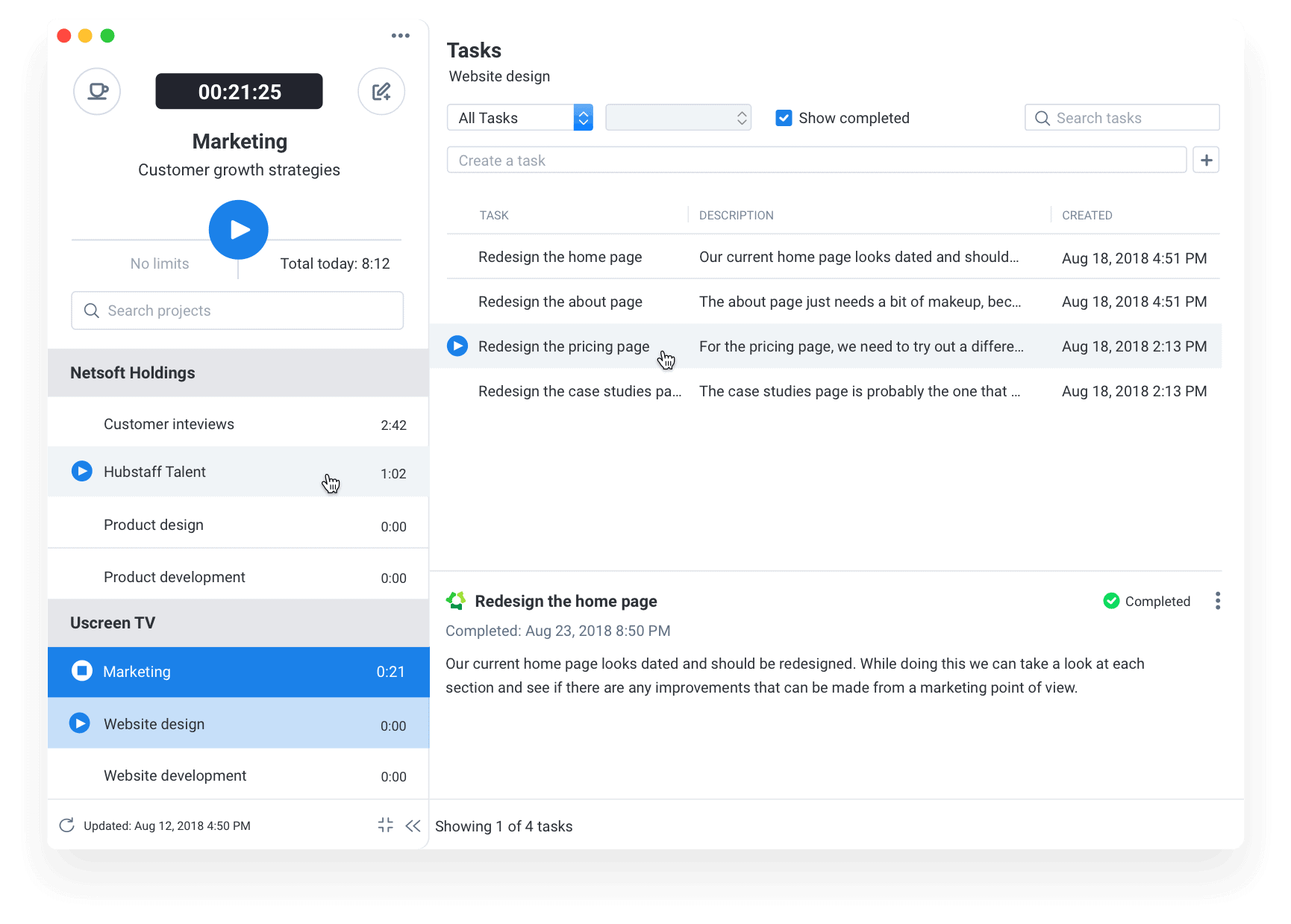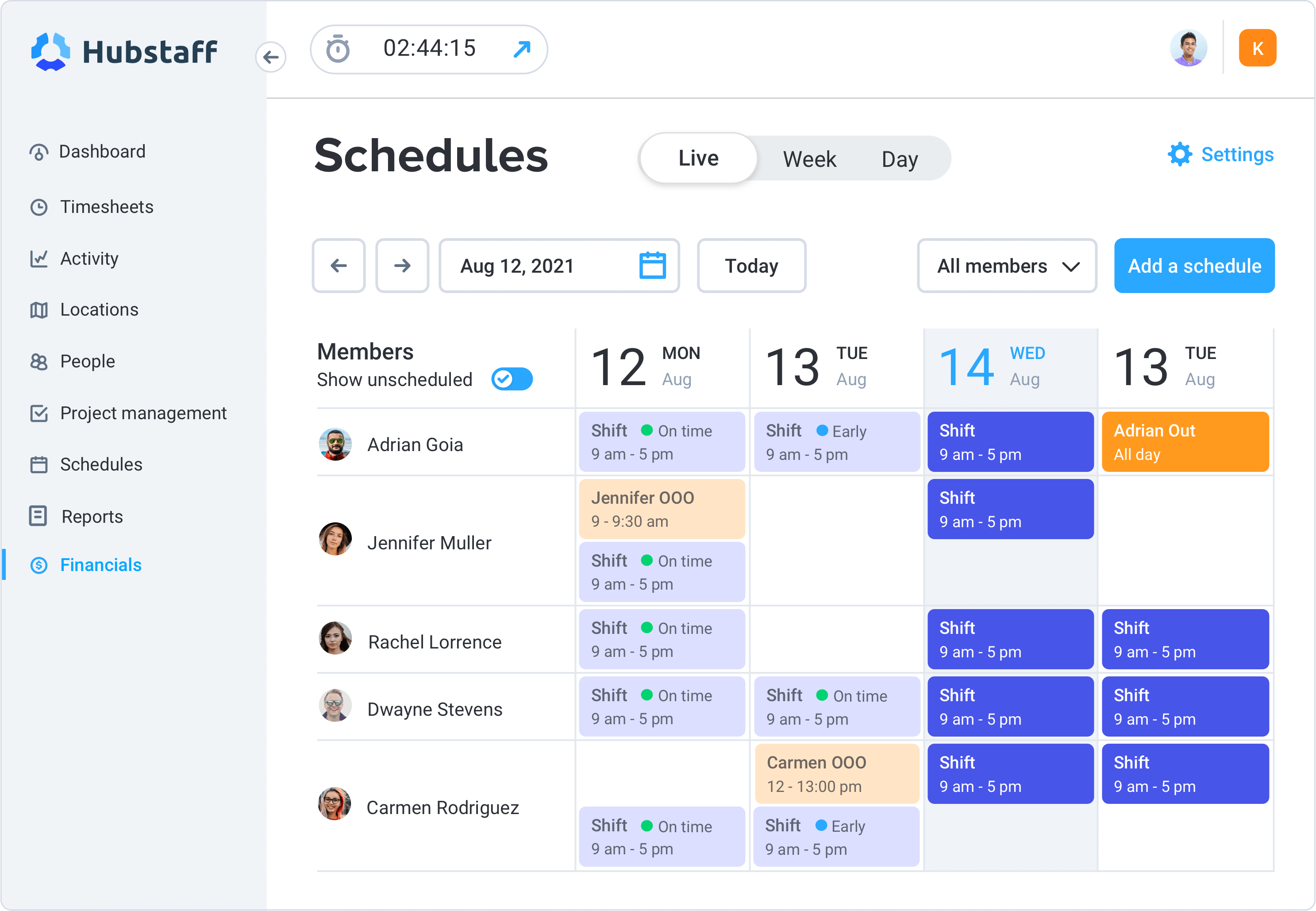Do you ever feel like managing shift schedules is like throwing a handful of darts and hoping one hits the dartboard? No matter how you draw up a roster, there always seems to be an unhappy employee.
If this is a familiar-sounding scenario, it’s time to talk about how time tracking software can positively impact employee scheduling. In this guide, you’ll learn everything you need to know about using time management systems to improve scheduling, reduce time-related stress, and transform your organization.
Boost your team’s efficiency with Hubstaff's productivity tools
What is Time Tracking, and How is it Used in Shift Management?
In theory, time tracking is simple—it’s the recording of hours worked by an employee. But to anyone that employs hourly staff, it’s a lot trickier to practice than it sounds.
When monitoring and managing shifts, it’s essential to have a time management system that facilitates accurate time tracking. This is the only way to ensure your employees work the correct hours and that you cover all the shifts on the schedule.
To ensure that hours and shifts are fairly allocated, you need to be able to see how many hours a person has worked within a particular time frame. Knowing this allows you to create schedules that don’t over or underwork employees. Failing to do so will have you racking up overtime costs and struggling with retention.
Rethinking Your Schedules for Improved Employee Engagement
According to Zippia, only 20% of people feel their work is under control daily. A lack of control causes time anxiety, which leads to stress, unhappiness, and a loss of productivity. Regaining and retaining control is something leaders need to know how to do — especially with shift work.
That said, if you want employees to be happy and engaged—thereby improving productivity—you need to think carefully about your schedules. A key area to consider is flexibility.
Numerous studies show that when you offer your employees a degree of flexibility in their shifts and hours, you significantly reduce absenteeism. You also improve employee turnover rates as employees are more inclined to stay longer at a job that gives them what they need.
However, this doesn’t mean that you throw away your schedule and stop structuring shifts altogether—most companies won’t survive a switch like that. What you can do is offer flexibility within the shifts.
For example, you can have a start and finish window for a shift. The window can be between 7:30 am and 9 am. Whatever time an employee starts, they must work their 8-hour shift and then finish at the corresponding time of day. This ensures that all employees are in the office for a core workday, but it allows them some flexibility for maintaining a better work/life balance.
How to Retain Long-Term Time Management Improvements
If you want the time management strategies you put in place to have any staying power, it’s important that you do your research. Get employee buy-in on the strategies, as this improves morale, reduces the chance of burnout, and ensures true progression.
1. Use Data to Assess Time Management Needs
The first step is to look at time-tracking data. Begin by assessing the absenteeism and lateness of employees and determine if there are any patterns. Also, consider the time spent on sales or projects. All these statistics will show you the levels of engagement your employees have with their jobs, as well as their general satisfaction with what they do.
One important factor is how much time employees spend on different tasks, such as their emails. According to a McKinsey study, employees can spend up to 28% of their workday reading emails and replying to them. This is easily mitigated through better communication channels such as phone calls or online chats to prevent back and fore over a topic.
2. Assess Productivity Levels Before and After Changes
You must know what the productivity levels are in your business before you start to make any changes to the shift schedule. There are several performance indicators that you can look at when measuring productivity.
These include:
- Profit levels on sales or jobs
- Completion of projects in specific time frames
- Levels of stock
- Customer satisfaction
- Employee assessments
Assessing productivity by looking at profits gives you a good indication of the health of your business. However, it doesn’t necessarily take into account the well-being of your employees or the time anxiety they feel when they’re facing mounting tasks and a clock that’s running down. This is why it’s good to also look at time management and employee assessments, as well as peer feedback.
Before implementing changes, be sure to take stock of your productivity levels. Then, you can see if anything changes after you implement a more flexible shift schedule or a different time management system. Having a baseline for comparison allows you to make better decisions for your business and your employees.
Time Management Systems Are The Answer
There are plenty of paid and free time tracking tools available online that make it easier to assess employee engagement and overall business operations.

Or, if you’re looking for an all-around, enterprise-grade solution, Hubstaff’s workforce management features make it a great solution for teams looking to optimize shift work.
The best part? Time tracking data converts into automated timesheets seamlessly. You can then integrate with your favorite payroll solutions like PayPal, Wise, and Gusto. Bring it all together with over 20 detailed reports and real-time productivity insights.

If your employees feel constantly scrutinized, micromanaged, or monitored too closely, you’ll struggle to get buy-in from them. The key is to find the tools that best suit your team and create policies on how you plan to use them.
Remember, reducing time anxiety and increasing flexibility and transparency will go a long way toward ensuring your employees are more engaged and productive.
About the author
Ida Ohlsson is a freelance editor with over 10 years of experience writing about the retail and hospitality industry. She has a deep understanding of the challenges when it comes to customer-centric industries businesses, and her work has been featured in publications such as Norseman Distillery, Thursd., Top Shelf, Food Wine Sunshine, and more.
Most popular
The Fundamentals of Employee Goal Setting
Employee goal setting is crucial for reaching broader business goals, but a lot of us struggle to know where to start. American...
Data-Driven Productivity with Hubstaff Insights: Webinar Recap
In our recent webinar, the product team provided a deep overview of the Hubstaff Insights add-on, a powerful productivity measurem...
The Critical Role of Employee Monitoring and Workplace Security
Why do we need employee monitoring and workplace security? Companies had to adapt fast when the world shifted to remote work...
15 Ways to Use AI in the Workforce
Whether through AI-powered project management, strategic planning, or simply automating simple admin work, we’ve seen a dramatic...





